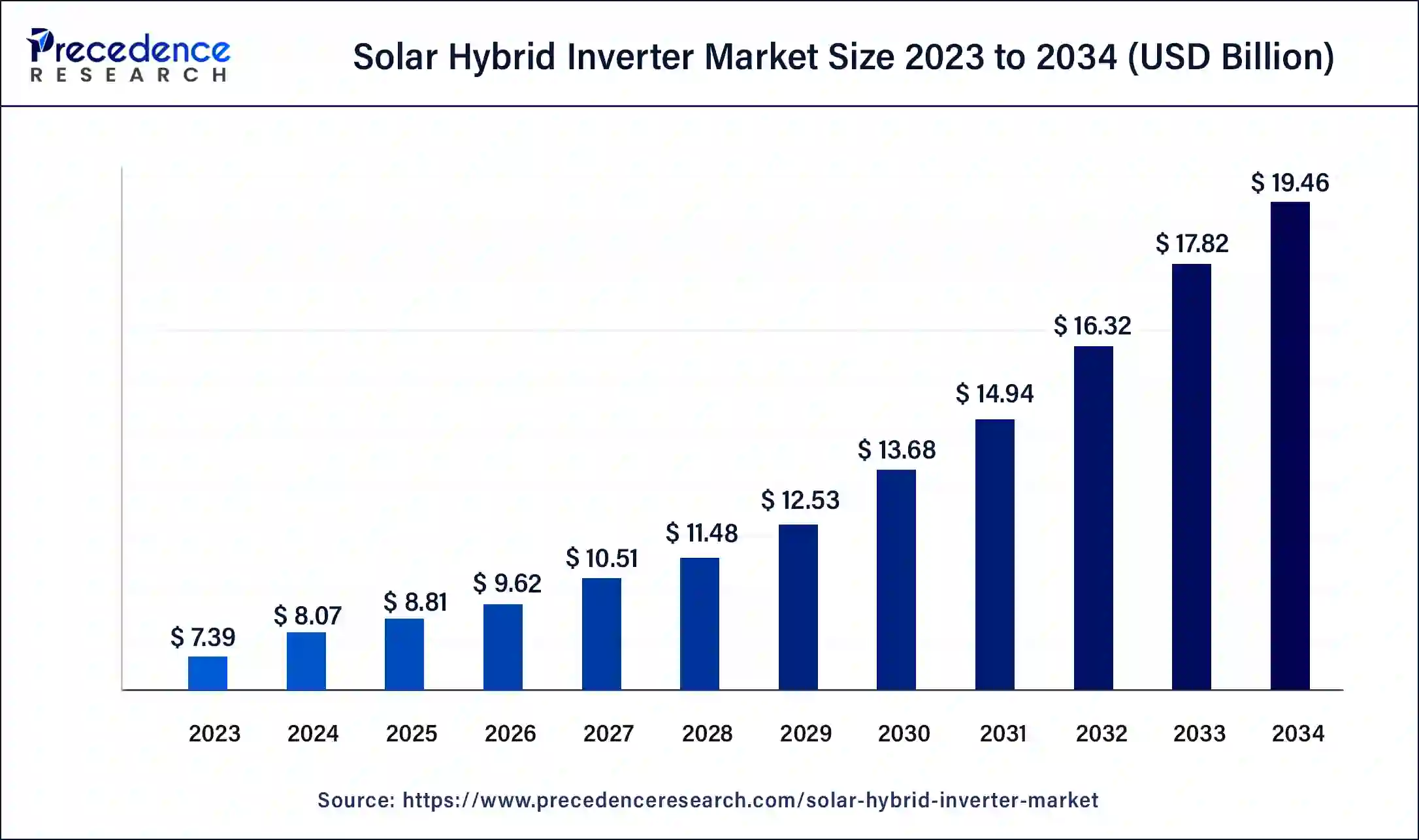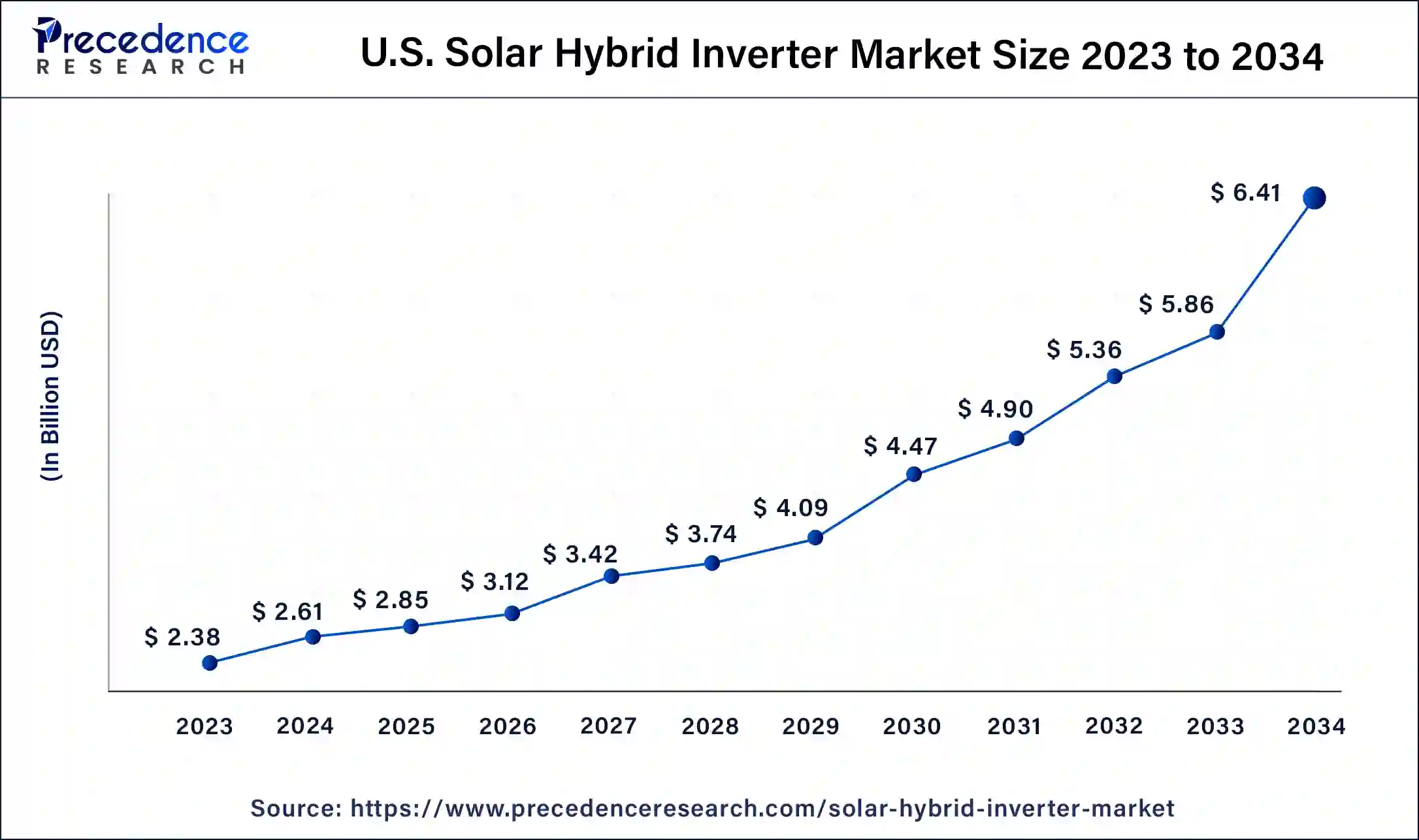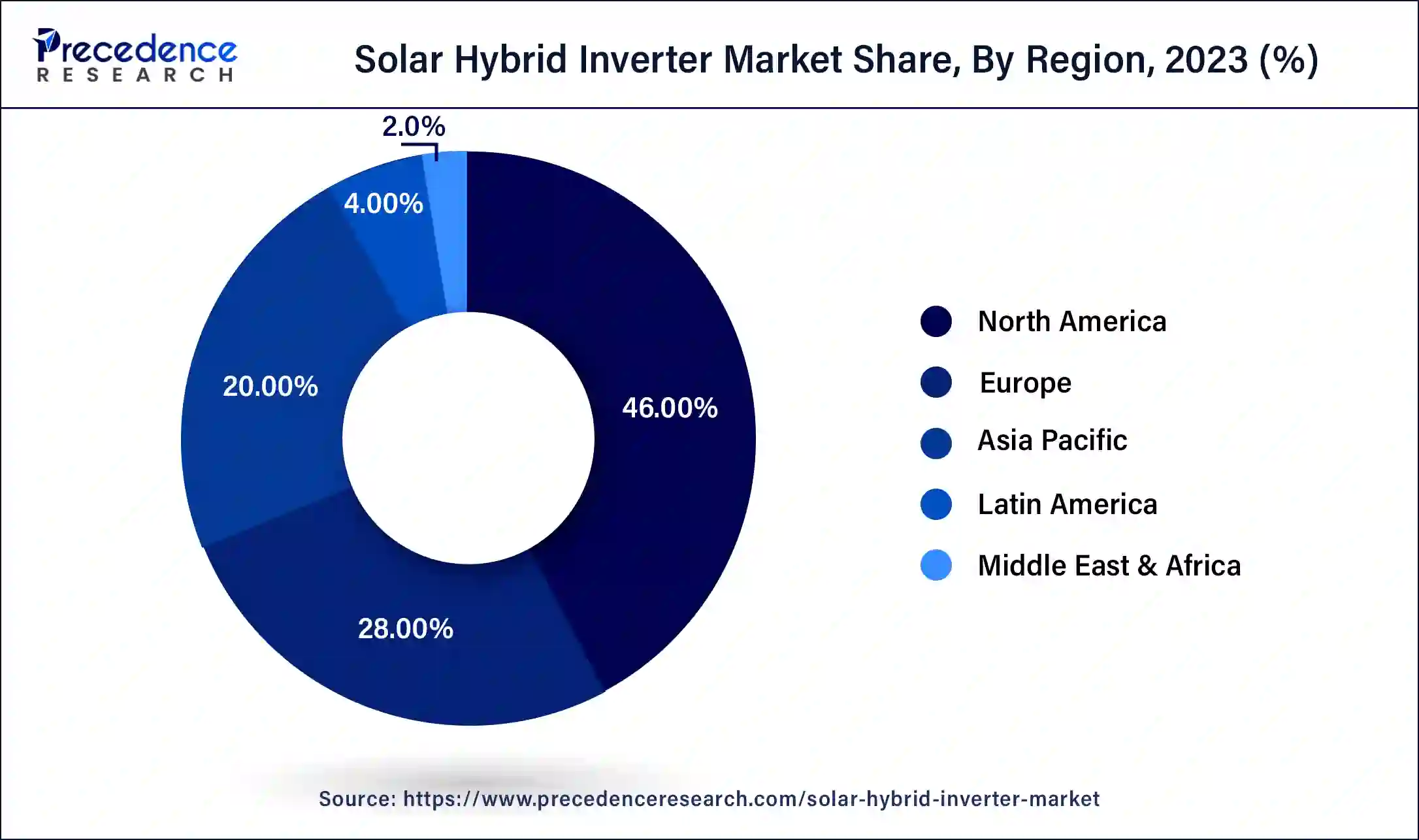October 2024
The global solar hybrid inverter market size was USD 7.39 billion in 2023, calculated at USD 8.07 billion in 2024 and is projected to surpass around USD 19.46 billion by 2034, expanding at a CAGR of 9.2% from 2024 to 2034.
The global solar hybrid inverter market size accounted for USD 8.07 billion in 2024 and is expected to be worth around USD 19.46 billion by 2034, at a CAGR of 9.2% from 2024 to 2034. The North America solar hybrid inverter market size reached USD 3.4 billion in 2023.

The U.S. solar hybrid inverter market size was estimated at USD 2.38 billion in 2023 and is predicted to be worth around USD 6.41 billion by 2034, at a CAGR of 9.4% from 2024 to 2034.

North America has held the largest revenue share 46% in 2023. In North America, the solar hybrid inverter market is witnessing robust growth due to increasing awareness of renewable energy and government initiatives promoting clean energy adoption. The region's high solar potential and a growing focus on sustainable practices contribute to the rising demand for solar hybrid inverters.
Additionally, favorable regulatory frameworks and incentives further encourage consumers to invest in solar energy solutions, driving the market's expansion. In North America, the solar hybrid inverter market is experiencing remarkable growth, owing to heightened awareness of renewable energy benefits. Government incentives and favorable regulations further propel the market, fostering a shift toward sustainable energy practices.

Asia-Pacific is estimated to observe the fastest expansion. Asia-Pacific is a pivotal player in the solar hybrid inverter market, experiencing rapid expansion due to surging solar installations, notably in countries like China and India. This growth is fueled by proactive government initiatives, such as subsidies and feed-in tariffs, encouraging widespread adoption of solar hybrid inverters across diverse sectors including residential, commercial, and industrial, marking a significant stride toward sustainable and renewable energy practices.
In the solar hybrid inverter market, Europe showcases a robust landscape marked by an increasing shift toward renewable energy. Stringent environmental regulations and ambitious sustainability targets set by European countries drive the adoption of solar hybrid inverters. The region witnesses significant integration of these inverters into smart grid systems, enhancing energy efficiency. This transition aligns with Europe's commitment to reducing carbon emissions and fostering a cleaner, greener energy infrastructure.
The solar hybrid inverter market encompasses a range of inverters that integrate solar power and grid electricity, catering to diverse consumer needs. These inverters play a pivotal role in harnessing solar energy for both residential and commercial purposes. They offer flexibility by allowing users to utilize solar power when available and seamlessly switch to grid power when needed.
This market responds to the increasing demand for sustainable and efficient energy solutions, providing a reliable source of power that reduces dependency on traditional grid systems. The Solar Hybrid Inverter Market aligns with the global shift towards cleaner and renewable energy alternatives. The solar hybrid inverter Market is witnessing significant growth due to its contribution to reducing carbon footprints and providing energy resilience. With advancements in technology, these inverters are becoming smarter, offering enhanced monitoring and control features, further driving their adoption in the transition towards sustainable energy solutions.
| Report Coverage | Details |
| Growth Rate from 2024 to 2034 | CAGR of 9.2% |
| Market Size in 2023 | USD 7.39 Billion |
| Market Size in 2024 | USD 8.07 Billion |
| Market Size by 2034 | USD 19.46 Billion |
| Largest Market | North America |
| Base Year | 2023 |
| Forecast Period | 2024 to 2034 |
| Segments Covered | By Product and By End User |
| Regions Covered | North America, Europe, Asia-Pacific, Latin America, and Middle East & Africa |
Renewable energy integration and technological advancements
The surge in market demand for solar hybrid inverters is propelled by the dual factors of renewable energy integration and continuous technological advancements. As the world increasingly embraces renewable energy sources, solar hybrid inverters play a pivotal role in seamlessly integrating solar power into existing energy grids. These inverters enable users to harness clean and sustainable energy from solar panels while maintaining a connection to the traditional grid. This integration ensures a reliable and continuous power supply, contributing to energy efficiency and sustainability goals.
Moreover, technological advancements have significantly enhanced the capabilities of solar hybrid inverters. Ongoing innovations focus on improving efficiency, increasing energy storage capacities, and integrating smart grid functionalities. These advancements make solar hybrid inverters more adaptable to diverse energy needs, providing users with greater control over their energy consumption. As the technology evolves, the market witnesses a growing demand for sophisticated inverters that offer enhanced performance, reliability, and seamless integration with evolving energy systems, further driving the overall market growth.
High initial costs and limited energy storage capacity
The solar hybrid inverter market faces challenges primarily associated with high initial costs and limited energy storage capacity. The upfront investment required for purchasing and installing solar hybrid inverters, which integrate solar panels with battery storage, can be substantial. Many consumers, especially in regions with less established financial incentives or lower income levels, may find the initial costs prohibitive, slowing down widespread adoption.
Additionally, the limited energy storage capacity of some solar hybrid inverters poses a constraint. Energy storage is critical for providing a continuous power supply during periods of low solar generation or at night. If the storage capacity is insufficient to meet the energy demands during these times, users may still need to rely on conventional grid power, reducing the overall effectiveness of the solar hybrid system. Addressing these challenges through cost reduction measures and advancements in energy storage technologies is crucial for overcoming barriers to broader market acceptance.
Rising demand for off-grid solutions and integration with smart technologies
The rising demand for off-grid solutions and the integration of solar hybrid inverters with smart technologies have significantly contributed to the surge in market demand. Off-grid solutions are increasingly sought after in remote areas or locations with unreliable grid access, where solar hybrid inverters serve as a reliable and independent power source. These inverters enable users to generate and store their electricity, ensuring a continuous power supply even in areas without a stable grid infrastructure.
Moreover, the integration of solar hybrid inverters with smart technologies enhances their functionality and appeal. Smart inverters can be remotely monitored and controlled, allowing users to optimize energy consumption, track performance, and receive real-time insights into their solar power generation. This integration aligns with the broader trend of creating sustainable and intelligent energy ecosystems. As consumers prioritize energy efficiency and environmental sustainability, the demand for solar hybrid inverters with off-grid capabilities and smart features continues to rise, propelling market growth.
According to the product, the grid-tied solar hybrid inverter segment held a 68% revenue share in 2023. Grid-tied solar hybrid inverters are designed to work in conjunction with the main power grid. They enable users to generate solar power while remaining connected to the grid. In the event of excess solar production, the surplus energy can be fed back into the grid. A notable trend in this segment is the increasing popularity of inverters with advanced grid management features, such as grid feedback control and frequency synchronization, ensuring seamless integration and efficient energy transfer.
The off-grid solar hybrid inverter segment is anticipated to expand at a significant CAGR of 12.1% during the projected period. Off-grid solar hybrid inverters operate independently of the main power grid, making them suitable for remote locations or areas with unreliable grid access. These inverters store excess solar energy in batteries for later use, providing a reliable power source even during grid outages. An emerging trend in off-grid inverters is the integration of advanced battery management systems (BMS) for enhanced energy storage efficiency. Additionally, there is a growing demand for off-grid inverters with increased power output capacity to cater to larger energy needs in off-grid applications.
Based on the end user, the commercial segment held the largest share of 42% in 2023. Commercial end users in the solar hybrid inverter market include businesses, offices, and institutions. The trend in the commercial sector involves adopting solar hybrid inverters as part of sustainable energy solutions. Businesses are increasingly integrating solar power into their operations to reduce reliance on the grid and lower energy costs. With a focus on corporate social responsibility, many commercial entities are investing in solar hybrid systems to achieve environmental goals and demonstrate their commitment to green practices.
On the other hand, the industrial segment is projected to grow at the fastest rate over the projected period. In the industrial segment, solar hybrid inverters are applied to meet the energy demands of manufacturing units, factories, and large-scale industrial operations. The trend here is driven by the need for reliable and uninterrupted power supply. Industries are deploying solar hybrid systems to ensure continuous operations and mitigate the impact of power outages. Additionally, the integration of energy storage solutions with solar inverters enables industries to optimize energy consumption, reduce peak demand charges, and enhance overall energy efficiency, contributing to cost savings and sustainability goals.
Segments Covered in the Report
By Product
By End User
By Geography
For inquiries regarding discounts, bulk purchases, or customization requests, please contact us at sales@precedenceresearch.com
No cookie-cutter, only authentic analysis – take the 1st step to become a Precedence Research client
October 2024
August 2024
January 2025
August 2024